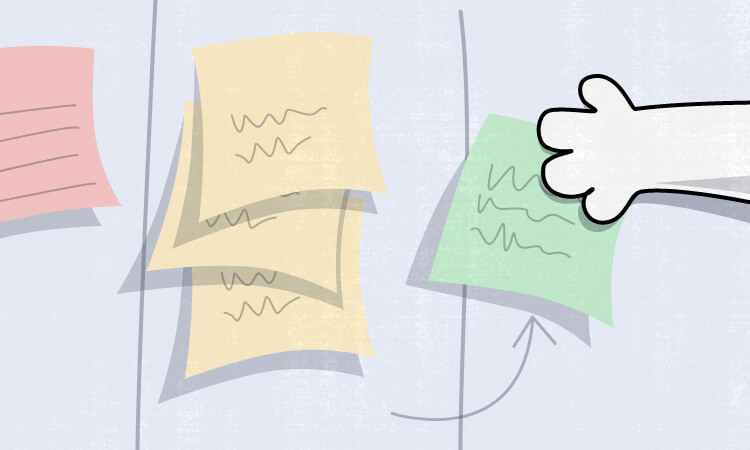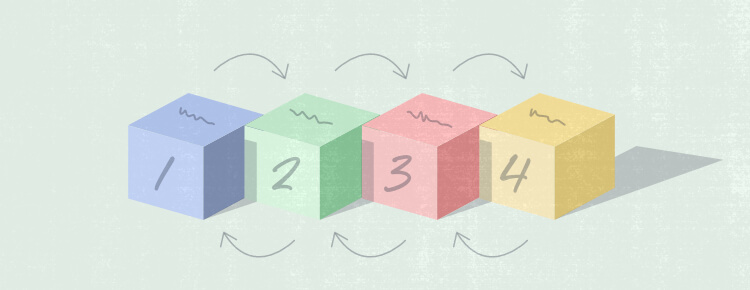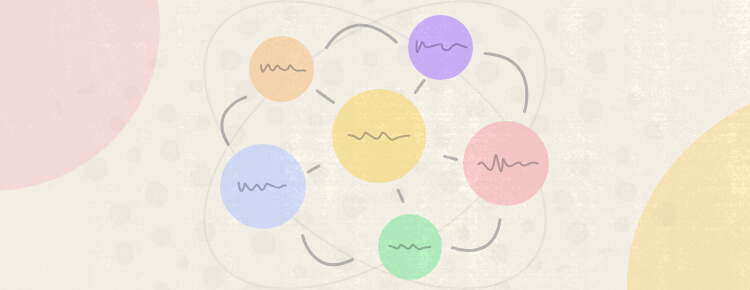What is Kanban project management exactly?

Kanban is one of the main project management methodologies around today. The word “Kanban” is billboard in Japanese and Kanban is called this because of it’s highly visual nature.
Kanban takes the lean, mean value-based agile principles of project management methodologies such as Lean and adds an emphasis on efficiency. It’s high on flexibility, self-management, teamwork, and collaboration. Kanban wants you to focus on the things that really matter.
History
The roots of the word Kanban date back to the 1600s, with the boom in the Japanese economy. Kanban, literally signboards or nowadays billboards were used to attract potential customers to shops and stores. The signs were artistic and attractive but most importantly clear and concise representations. From these historical roots came the modern-day project management methodology of Kanban as introduced in the 1940s by Toyota, at the time a post-war war loss-making former giant. Unable to compete with the American car manufacturing giants across the pacific Toyota embarked on a journey of corporate culture change. Thus Kanban project management methodology was born under the development innovation of Taiichi Ohno to improve and maintain a high level of production
This idea was then applied to IT, Software development and knowledge work in general in the year 2004 by David J. Anderson.
What is the Kanban system?

Kanban is a highly visual system for managing projects as they move through a process. The system involves both the visualization of the process (the workflow) and the actual work passing through that process. The principle aim of Kanban is to identify potential hold-ups, bottlenecks, in the process and fix them quickly so work can move on cost-effectively at a steady pace towards completion of the whole project.
It is based on four foundation principles and six practices;
4 Foundational Principles

- Start with what you are doing now: changing your whole system overnight is often not a practical option. Apply Kanban to your present workflow system as fittingly and smoothly as possible and then introduce further changes over a period of time, when the team and system is ready to cope.
- Agree to pursue step-by-step, gradual change over time: this will lead to acceptance by the team and organization rather than disruptive resistance. Don’t be too radical too quickly. Kanban moves on when everybody is onside and working together.
- Initially, respect current workplace roles, responsibilities and job-titles: Kanban doesn’t insist on immediate change to staffing roles and responsibilities and doesn’t require organizational changes. Gradually teams will collaborate to identify and put forth changes needed in this area.
- The first three foundation principles are all based on the avoidance of natural human emotions to resist change. Any change is slow, gradual, evolutionary, and seen to be collaborative. As such these changes give the new system a better chance of success, without immediately alienating the current staff.
- Leadership at all levels is encouraged: All levels of workers can have input, come up with ideas and suggestions, and ought to be vital links in collaboration. This kind of initiative is valued and welcomed.
6 Core Practices of the Kanban Method

- Visualize the flow of work: the fundamental first step to the Kanban Method. Visualize the workflow process, some people use a physical whiteboard others an online Kanban Board. Spell out this process in clear steps so you have a very clear visual representation of each stage. Start simple, with basic stages and one flow line, and add to it as complexity increases.
- Limit WIP (Work in Progress): Kanban is a “pull system” so work should be completed and marked as such before starting the next stage. Limiting work-in-progress (WIP) is vital to the implementation of Kanban project management. It may not be easy to do this at the very beginning of a project and it is absolutely possible to create limits during the process as and when you get more information and data on the progression of the project. This system helps the team members progress through stages, improves engagement, and communicates capacity and work limits to clients, customers, and other stakeholders which in turn improves long term planning.
- Manage Flow: Once you’ve got your visualization of workflow and managed to establish Work-in-progress limits, then it’s all about managing and improving flow. The Kanban project management system should help manage flow by breaking down the different stages of the workflow and showing the status of work in each stage. You should be able to identify smooth flow or bottlenecks quickly and easily, then if needed adjustments should be made to improve flow, which in turn should reduce the time taken to complete each stage of work, and overall cycle time. This workflow improvement and smoothness should lead to greater predictability, and therefore accurate timelines and deadlines.
- Explicit Process Policies: your process guidelines laying out exactly how you do the things you do and what rules and procedures you follow should be absolutely clear. Everyone needs to fully understand the requirements of any type of work being undertaken. These guidelines are best displayed at the top of the communication board so they are obvious and clear, and unmistakable.
- Feedback Loops Implementation: The Kanban system sets great stall on feedback of all kinds and sees it as one of the core practices. Stages are reviewed, and the idea is to get lots of feedback early to avoid going off track and therefore saving time. Kanban encourages continuous highly visual feedback.
- Collaboration and experimentation: as an evolutionary process kanban is a method that purposely integrates changes and experimentation, test and change in its doctrine. Test, evaluate, change, tweak, and improve as often and as much as needed.
What are Kanban boards, columns, and cards
When you are researching or reading up on Kanban project management you’ll hear a lot of terms repeated and repeated. Kanban boards, columns, and kanban cards – so let’s look at what exactly we are talking about here.
Kanban boards

A Kanban board is one of the main tools that you’ll certainly become aware of. Put simply, a Kanban board is the board, (physical or digital) where your work stages and process are depicted, and cards are placed to represent work items and stages. The board should start off simply but can become more complicated depending on the nature of the project. Often the board is divided up into “swim lines” to represent different work or indeed different teams. The boards are updated by team members thus saving you valuable time normally spent walking around requesting status updates.
Kanban columns

Kanban boards are usually broken up into what are known as columns, the most straightforward pattern being the three-column pattern of; To Do, Doing and Done or Requested, In Progress and Done. Of course, they can be much more complex than this. Each column is a representation of a specific activity.
Kanban cards

Kanban cards are visual representations of each work item. These cards give a clear instant representation of the work item but also can contain key detailed information, describe the work or estimated size of the work, record data, or record who this work has been assigned to.
The rear of the cards are often used to add extra information such as start and finish dates, blockages and any issues faced.
How to use Kanban for project management – a practical example
Let’s quickly guide you through the stages of very practical usage of Kanban
1. Create a board
First create a board one per project or per feature, that depends on the project size. Decent will it be a physical whiteboard type, a huge wall or something digital? Much depends on the physicality and location of your team members. You can download free Kanban boards online or use online tools to create your own. Start simple and use the help available online.
2. Add columns
Define your columns, with clear criteria so no one is in any doubt or confusion about the meanings. The three most popular columns are “TO-DO”, “Doing” and “Done” and it’s a great starting point. Much depends on your individual project workflow, common additions are things like next, blocked or canceled. Columns can also have subsections, such as being built, being designed, testing. This is also the stage where you should decide on whether or not you need vertical columns for different teams, different components or swim lines, etc.
3. Add cards
Once you’ve got your board ordered and designed, you need to move on to populating it with Kanban cards. The cards should be individual discrete items and have clear but brief descriptions and due dates and be placed in priority order with the most important at the top and then descending order.
4. Assign cards to team members
When the cards have been added, now is the time to assign team roles. Remember kanban works best when everybody is onside, so collaboration and discussion are the names of the game when assigning tasks.
Kanban benefits
The question remains, why has the Kanban project management system become and indeed sustained long term popularity. The reasons are clear, it has a number of benefits that fit comfortably with many modern projects especially in the world of IT and software development.
Better visibility
Everything about Kanban is about better visualization. The great benefit of this is that every member of the team sees the process and progress, and possible issues can be addressed before they get out of hand. This ensures the project manager is one step ahead and not always firefighting problems.
From this improved visibility comes a whole range of further direct benefits.
Greater efficiency
Getting more done is the wish of every project manager, and Kanban’s aim to improve the workflow should result in getting more done whilst using essentially the same resources. As you are able to identify areas of inefficiency, you can immediately do something about it.
Increased productivity
With improved efficiency comes increased productivity. Kanban needs timed deliveries and focus on finished work. Improved productivity is a direct result of this focus.
Improved efficiency naturally leads to the next Kanban benefit, which is increased productivity. Kanban benefits your productivity by shifting the focus from starting work to finishing work.
More Flexibility
Kanban is an agile strategy, which means that flexibility is an important factor. Kanban is a plan of individual actions rather than an overall project plan and so project managers have freedom and a flexibility of approach to priorities that can come with market or client changes. With no prescribed phase durations, features are released as soon as they are completed.
Further benefits
Kanban increases the focus of the team by focusing on specific single tasks and finishing those tasks before starting another. This is contrary to popular opinion the most efficient way of working.
Better collaboration as team members are encouraged to work together and offer opinions and advice. Team members should also be included in organizational meetings, prioritizing, and brainstorming sessions. Kanban works best when everyone feels part of one team.
Reduces waste, kanban is a lean project management methodology that aims to eliminate anything that doesn’t add value to the overall product.
Deadline predictability, once up and running the Kanban system should be stable and based on data with tasks coming in equal to tasks being delivered. A project manager should be able to make pretty accurate timelines of workflow and thus estimate delivery more accurately.
When to use Kanban

Kanban is one of a number of very popular project management methodologies and isn’t a magic bullet for every business or indeed every type of project. There are some general rules for when Kanban is more appropriate, but you are big enough to make your own decisions.
- When you process need to be optimized not transformed
- When you are looking at a long term evolutionary change
- When you have identifiable, repeatable workflow stages and processes.
- When you want to focus on delivery, not endless preplanning
- When you want to focus on continual improvement and change
Final words
From the early days in the backstreets of Japan to a worldwide project management methodology Kanban has transformed many businesses, with consistent evolutionary change and a flexible approach. It is ideal for certain projects, especially IT and software development where experts are given autonomy and trust and encouraged to be active team members.
It is a system that is well worth thinking about, you may very well already manage in a similar style without putting the definitions into the theory.
As with all theories, they can help, they can give you ideas, framework, systems but you and your team have to implement them, and make sure they work – and that is down to your hard work and skills.